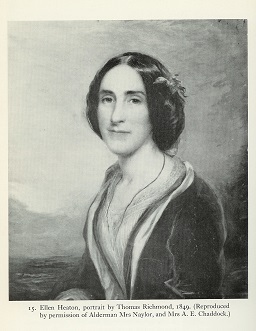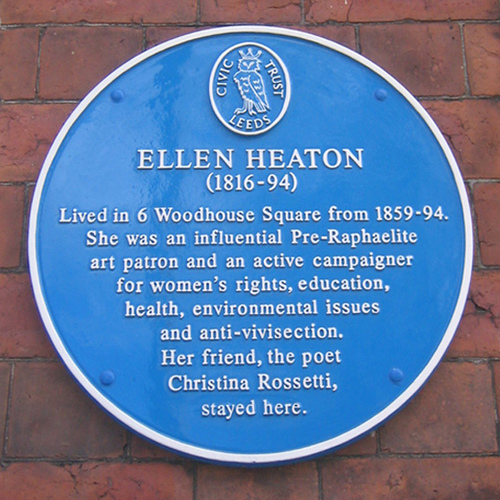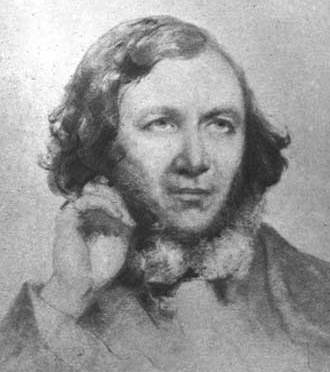Ellen Heaton
Ellen was born on 8 November 1816 at 7 Briggate, Leeds, the only daughter of John Heaton, bookseller, stationer and druggist, and his second wife, Ann Deakin. The family were originally Baptist but converted to the Church of England in the 1820s.

When Ellen’s father retired, the family moved to Park Square and, after her mother’s death, Ellen kept house for her father. When he died she inherited enough property and investments to make her independent – although her wealth was tied up in a Trust managed by her brother.
In 1847 she had her portrait painted by the society portraitist, Thomas Richmond, (who also painted Charlotte Bronte and Mrs Gaskell). When Ellen expressed an interest in starting an art collection, Richmond recommended that she write to the influential art critic John Ruskin.
This was the beginning of a lengthy correspondence in which Ruskin mentored her and guided her purchases of Pre-Raphaelite art. This in turn led to her sponsorship of Dante Gabriel Rossetti and her friendship with his sister, the poet Christina Rossetti.
Ellen was educated with her younger brother John Deakin Heaton (born 23 November 1817) until he was sent to Leeds Grammar School. While John studied at Cambridge University, Leeds Medical School (in 1835) and University College Hospital in London, Ellen went to a day school for girls on Wellington Street. In 1833 she had one term boarding at Roe Head School in Mirfield: she arrived about 6 months after Charlotte Bronte left but was a contemporary of Charlotte’s friends, Ellen Nussey and Mary Taylor.
Ellen remained sensitive about her lack of formal education and created her own intellectual life. She joined the Leeds Library, the Leeds Philosophical & Literary Society and attended the annual meetings of the British Association for the Advancement of Science and the National Association for the Promotion of Social Science.
In 1853 Ellen travelled to Italy with an older friend, the author, Fanny Haworth who introduced her to the poets, Robert Browning, and his wife Elizabeth Barrett Browning then living in Florence. There are some snobbish comments in Elizabeth Barrett Brownings’s letters, ridiculing Ellen’s Yorkshire accent, her enthusiasms and “provincial” manners.
When Ellen returned to Leeds, John Heaton purchased 6 Woodhouse Square as her home. It is now the Swathmore Centre and bears a blue plaque to Ellen.

It is only a short distance from where John and his wife, Fanny, lived at Claremont on Clarendon Road. It was in Claremont, during a visit from Emily Davies and Elizabeth Garrett Anderson in 1865 that the Heatons became involved in the campaign to improve women’s education and to open University education to them.
Cambridge and Oxford Universities were persuaded to establish external, competitive, examinations for women. Initially designed to provide qualifications for women teachers, they proved so popular that their remit was extended to all women over the age of 14 and to five towns in the north of England.
In Leeds, a small committee, on which both Ellen and Fanny served, arranged the Cambridge examinations. The committee then formed itself into the Leeds Ladies’ Education Association. They funded a Leeds Scholarship to Emily Davies’s “new college in Hitchin”. The first scholarship was worth £100 guineas to cover three years of study; Ellen contributed £5. Hitchin College went on to become Girton College, Cambridge.
After their meeting, Emily Davies invited Ellen to join the Kensington Society. These were the women who campaigned for reform of laws relating to married women’s property and divorce and for women to study medicine.
Each month the Society chose a topic to debate and every member had to submit a paper. On 21 November 1865, the topic was the extension of the parliamentary franchise for women.
The following year John Stuart Mill, Liberal MP for Westminster, agreed to the Society’s request that he present a petition in favour of women’s suffrage to the House of Commons. He asked that they collect a minimum of 100 signatures.
It has been suggested that Ellen collected the signatures in Leeds. However, there is no mention of this activity in John Heaton’s surviving diaries. As he was opposed to women’s suffrage, it is hard to believe he would have approved and his diaries reflect a growing irritation with what he viewed as Ellen’s eccentricities. A more likely candidate is the school teacher, Constance Holland.
After the petition, women’s suffrage societies were formed in London, Manchester and Edinburgh. There is no record that Ellen attended the women’s suffrage meetings held at the Leeds Mechanics’ Institute nor that she joined or supported the Leeds Women’s Suffrage Society.
Both Ellen and Fanny Heaton were, however, very much involved with the newly formed Yorkshire Ladies’ Council of Education. Ellen served as the Secretary of the Committee organising university extension lectures for the women taking the Oxford Examinations and lectures to working-women on sanitation and physiology (see the biography of Mrs Catherine Buckton).
Later, with her brother, Ellen was involved in arranging University Extension lectures for working men. This evolved into the Workers’ Education Association, and then the founding of the Yorkshire College, which became into the University of Leeds.
Ellen was also Treasurer to the Yorkshire Ladies’ Committee which campaigned to open a High School for Girls in Leeds. This was achieved against considerable opposition in 1875. At a time when it was commonly believed that intellectual activity adversely affected a woman’s ability to have children, the students at Leeds Girls High School followed the same academic curriculum taught at the Grammar School for Boys. It was the first school in Leeds to prepare girls for university entrance examinations.
Ellen stood unsuccessfully to become the first woman on the Committee for the Leeds Library in 1886 and 1887. A woman was not elected until 1921.
Ellen outlived most of her family, dying in 1894.
She continued to travel extensively, even going to Poland and Russia.
Most of her extension art collection was bequeathed to her only surviving nephew who, in his turn, donated them to the nation in 1940. They now form the basis of the Tate Gallery’s Pre-Raphaelite collection.
The portraits of Robert Browning and Elizabeth Barrett Browning (below), commissioned by Ellen from Field Talfourd were left to the National Portrait Gallery.


Her nephew gave Ellen’s house in Woodhouse Square to the city of Leeds, Leeds then sold it to the Quaker educational charity which operates the Swarthmore Centre when they needed to expand.
The Swarthmore Centre holds an annual public lecture in her honour.